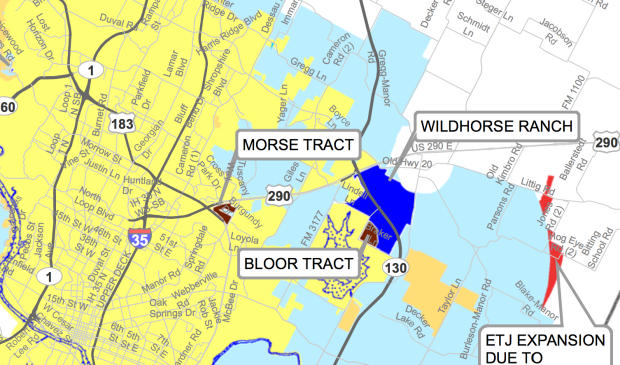County ponders first Public Improvement District
Wednesday, December 2, 2015 by
Tyler Whitson The Travis County Commissioners Court held a public hearing on Tuesday about a petition to create the Wildhorse Ranch Public Improvement District, which, if approved, would be the first development of its kind created by the county.
Commissioners also provided direction to staff on crafting a broader policy for creating such districts that it will consider before voting on the current petition.
“Right now, we’re in a period of taking a look at it, kicking the tires on it,” County Judge Sarah Eckhardt told the Austin Monitor.
“I’m cautiously optimistic that this is good. I see great benefit, from a policy standpoint, of utilizing Public Improvement Districts in order to get a higher standard of development in the unincorporated areas of Travis County,” Eckhardt continued. “We can only ask for so much from a developer under (state) statute, but by having this extra tool – a public improvement district – we have the chance of leveraging a much higher quality product with developers.”
Commissioners will consider adopting a Public Improvement District policy on Jan. 12. It will revisit the Wildhorse Ranch public hearing – which remains open – and possibly take action to approve the petition on Jan. 19.
According to the Texas Comptroller of Public Accounts, creation of a public improvement district “allows cities and counties to levy and collect special assessments on properties that are within the city or its extraterritorial jurisdiction.”
“It doesn’t go against our debt at all,” said Diana Ramirez, assistant budget director for Travis County.
Those special assessments, which can come in the form of property taxes that apply only within the district, can go toward public infrastructure and service improvements within the district.
In the case of Wildhorse Ranch – a 1,600-acre development proposed in eastern Travis County between Walter E. Long Metropolitan Park and the city of Manor – the funds would go toward building and maintaining streets; establishing parks and related facilities; constructing water, wastewater and drainage infrastructure; carrying out landscaping projects; and more.
The cost of all that work is estimated at $65 million plus bond issuance and other costs.
Under state law, more than 50 percent of the affected landowners must be on board in order to petition to create a Public Improvement District. The development tool is usually used by cities – Austin’s Whisper Valley Public Improvement District is one example – and rarely by counties, considering that Hays County is the only one in the state to have used it to date.
In fact, the landowners who are petitioning the county as of Oct. 13 began by petitioning the city of Austin, which annexed the property from its limited-purpose jurisdiction into its full-purpose jurisdiction in 2013.
“The kind of centerpiece of this is a major roadway called the Wildhorse Connector, which was approved through a Travis County bond election in … 2011,” attorney David Armbrust told the Monitor. “When the voters approved it, they approved a joint participation agreement envisioning that the road would be partially funded by the developer, partially by the county.”
Armbrust represents Wildhorse Ranch developer Pete Dwyer, who has been involved with the long-running development effort since its proposal.
Armbrust explained that the idea of petitioning the city for a Public Improvement District came in 2014, as a county deadline for a participation agreement on the road loomed toward the end of the year. “Because the property was annexed, we started working with the city,” he said, adding that the county agreed at that time to postpone its deadline until August.
“We continued to work with the city, and we were kind of moving along – we’d been to one of the (City) Council subcommittees a couple of times – but we were running out of time and … we asked for another extension, so the county commissioners extended it until Nov. 30 to have this funding mechanism in place,” Armbrust continued.
“It kind of finally all dawned on us this fall, saying, ‘You know what? This is a county project. Even though the land’s been annexed, we’re really talking about major road infrastructure that was approved by the voters, by the county,’” Armbrust said.
Although Austin City Council has not officially weighed in on the petition with the county – which the city could deny under state law – the city’s Chief Financial Officer Elaine Hart was present at the hearing.
The talks between the county and the city are “very convivial,” Eckhardt said. “We are working very closely with the city staff, who would be looking at this PID but for the applicant asking us to manage it. There is no ill will at all – there seems to be a great degree of camaraderie, wanting to make sure that the city and the county are in concert as we move forward with this.”
Armbrust said during the public hearing that creating the PID “really is pretty much just drawing lines on a paper and establishing boundaries” and that “there’s a lot of work to be done before any bonds would be issued.”
Map of 2013 city annexations courtesy of the city of Austin.
You're a community leader
And we’re honored you look to us for serious, in-depth news. You know a strong community needs local and dedicated watchdog reporting. We’re here for you and that won’t change. Now will you take the powerful next step and support our nonprofit news organization?









